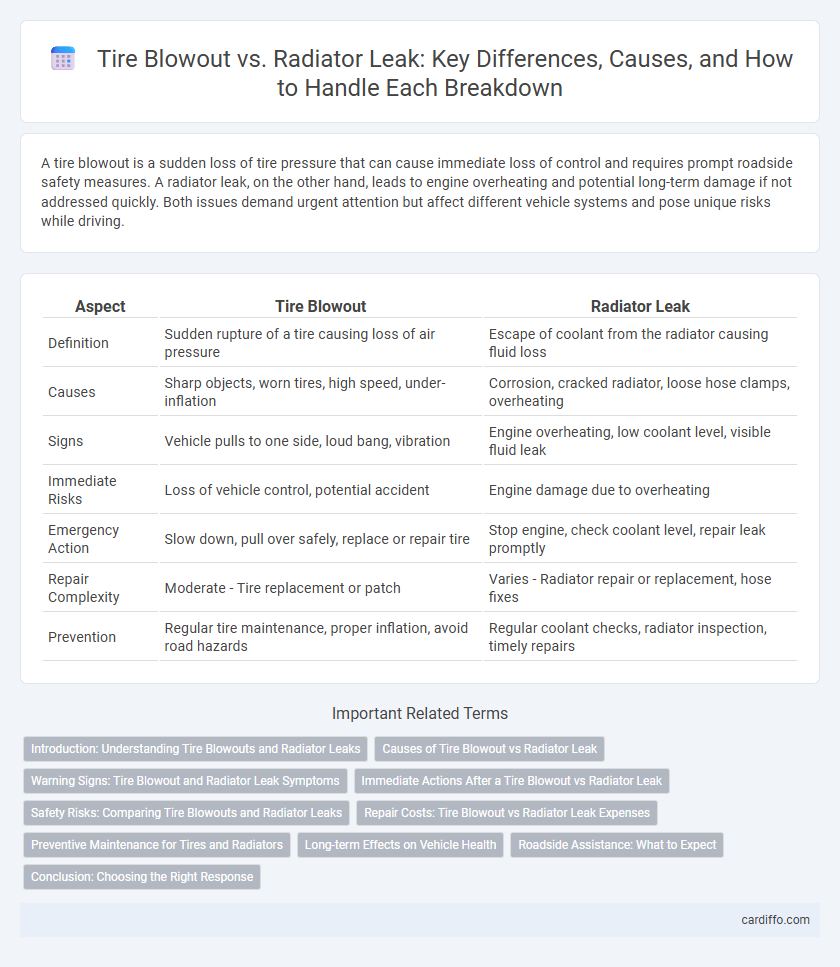A tire blowout is a sudden loss of tire pressure that can cause immediate loss of control and requires prompt roadside safety measures. A radiator leak, on the other hand, leads to engine overheating and potential long-term damage if not addressed quickly. Both issues demand urgent attention but affect different vehicle systems and pose unique risks while driving.
Table of Comparison
| Aspect | Tire Blowout | Radiator Leak |
|---|---|---|
| Definition | Sudden rupture of a tire causing loss of air pressure | Escape of coolant from the radiator causing fluid loss |
| Causes | Sharp objects, worn tires, high speed, under-inflation | Corrosion, cracked radiator, loose hose clamps, overheating |
| Signs | Vehicle pulls to one side, loud bang, vibration | Engine overheating, low coolant level, visible fluid leak |
| Immediate Risks | Loss of vehicle control, potential accident | Engine damage due to overheating |
| Emergency Action | Slow down, pull over safely, replace or repair tire | Stop engine, check coolant level, repair leak promptly |
| Repair Complexity | Moderate - Tire replacement or patch | Varies - Radiator repair or replacement, hose fixes |
| Prevention | Regular tire maintenance, proper inflation, avoid road hazards | Regular coolant checks, radiator inspection, timely repairs |
Introduction: Understanding Tire Blowouts and Radiator Leaks
Tire blowouts and radiator leaks represent critical vehicle issues that can lead to roadside breakdowns. A tire blowout involves a sudden loss of tire pressure, often caused by punctures, worn-out tires, or overheating, resulting in immediate loss of vehicle control. Radiator leaks occur when coolant escapes due to cracks or corrosion, causing engine overheating and potential mechanical failure.
Causes of Tire Blowout vs Radiator Leak
Tire blowouts commonly result from underinflation, overloading, or hitting sharp objects that damage the tire's structural integrity. Radiator leaks typically occur due to corrosion, faulty hoses, or pressure buildup within the cooling system. Understanding these distinct causes helps in diagnosing vehicle breakdowns and applying the correct preventive measures.
Warning Signs: Tire Blowout and Radiator Leak Symptoms
A tire blowout often presents warning signs such as sudden loss of pressure, loud popping sounds, and vehicle vibration or pulling to one side. Radiator leaks are typically indicated by symptoms like low coolant levels, overheating engine, and visible coolant puddles under the vehicle. Recognizing these distinct warning signs allows for timely intervention, preventing further vehicle damage and ensuring safety on the road.
Immediate Actions After a Tire Blowout vs Radiator Leak
During a tire blowout, immediately grip the steering wheel firmly, avoid sudden braking, and gradually slow down to a safe stop off the road to prevent loss of control. In the case of a radiator leak, pull over quickly to avoid engine overheating, turn off the engine, and allow it to cool before checking coolant levels or calling for roadside assistance. Swift and appropriate responses to both emergencies can minimize damage and ensure driver safety during breakdowns.
Safety Risks: Comparing Tire Blowouts and Radiator Leaks
Tire blowouts pose immediate and severe safety risks, often causing sudden loss of vehicle control and increasing the likelihood of accidents at high speeds. Radiator leaks, while less sudden, can lead to engine overheating, causing the vehicle to stall unexpectedly and potentially leaving drivers stranded in unsafe locations. Both issues demand prompt attention, but tire blowouts generally present a more critical threat to driver and passenger safety due to their abrupt nature.
Repair Costs: Tire Blowout vs Radiator Leak Expenses
Repair costs for a tire blowout typically range from $100 to $400 depending on tire type and labor fees, while radiator leak repairs can cost between $300 and $1,200 due to parts replacement and labor intensity. Tire blowout expenses often involve immediate tire replacement or patching, whereas radiator leaks may require flushing, seal replacement, or full radiator substitution. Understanding these cost variations helps prioritize budget allocation during vehicle breakdown management.
Preventive Maintenance for Tires and Radiators
Regular tire inspections, including tread depth measurement and checking for sidewall damage, significantly reduce the risk of tire blowouts by identifying potential weaknesses early. Radiator maintenance involves frequent coolant level checks and flushing the cooling system as recommended to prevent leaks and overheating. Implementing these preventive measures enhances vehicle safety, extends the lifespan of tires and radiators, and minimizes costly roadside breakdowns.
Long-term Effects on Vehicle Health
A tire blowout typically causes immediate damage such as wheel misalignment and suspension strain, which, if unaddressed, leads to uneven tire wear and compromised handling over time. A radiator leak results in coolant loss and engine overheating, causing severe engine damage, including warped cylinders and head gasket failure that degrade long-term engine performance. Both issues demand prompt repair to prevent escalating vehicle health deterioration and costly future repairs.
Roadside Assistance: What to Expect
During a tire blowout, roadside assistance typically involves tire replacement or repair on-site, ensuring safe vehicle operation before continuation. In contrast, a radiator leak often requires fluid top-up and temporary sealing, with potential towing to a repair shop for comprehensive damage assessment. Both scenarios prioritize prompt response and safety, but the nature of the repairs and equipment needed differ significantly.
Conclusion: Choosing the Right Response
Responding effectively to a tire blowout requires immediate vehicle control and safe stopping to prevent accidents, while a radiator leak demands prompt cooling system checks to avoid engine overheating. Identifying the issue quickly ensures appropriate actions, such as replacing the tire or repairing the radiator, minimize further damage and maintain vehicle safety. Prioritizing rapid diagnosis and tailored responses optimizes breakdown management and reduces repair costs.
Tire blowout vs radiator leak Infographic

 cardiffo.com
cardiffo.com